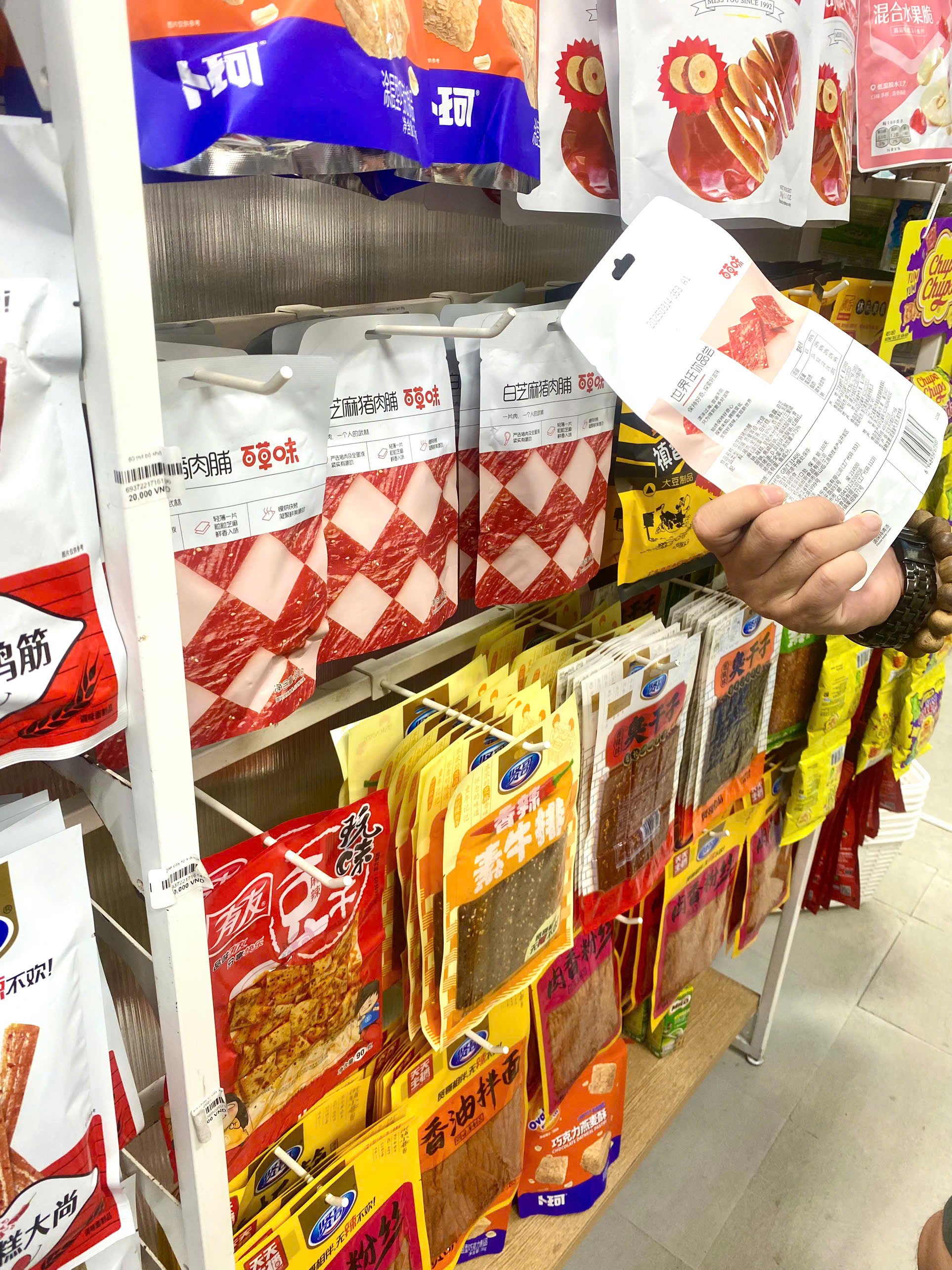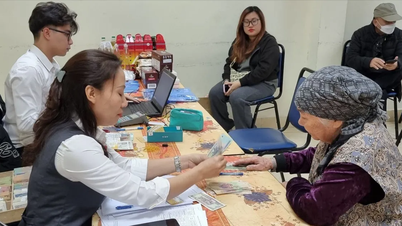Hundreds of snack items printed in foreign languages, without Vietnamese labels, are sold at a convenience store in Dong Ha City - Photo: HN
At 8 p.m. at a convenience store in Dong Ha City, reporters recorded many young people, teenagers, and children gathering to eat and drink. Here, customers can come to buy take-out items and choose their own dishes, mix instant noodles, spicy noodles to enjoy on the spot. Chicken feet, duck feet, sausages, spicy fish, instant noodles, dried meats, candies..., colorful snacks of all kinds are fully displayed on the shelves with prices ranging from 10,000 to 100,000 VND.
One worrying thing is that when wanting to see the list of ingredients and origin of most of the above products, buyers cannot find a secondary label in Vietnamese, and there is no name of the responsible importer printed on the packaging.
When asked about this, the seller said: “This is a domestic product imported directly from China, it must be a machine error that has not scanned the label yet. But I guarantee that these are all quality products.” Because they could not read the specific foreign language text on the product packaging, the sales staff continued to explain briefly and then left.
Interviewing some customers who come here to buy, the reporter learned that they come to buy because they see advertisements, review videos on tiktok, facebook or simply buy for their children, "buy to eat according to the trend" because this dish is "hot". Not only young people, many adults are also caught up in this consumer trend.
Ms. Tran Huong, in Ward 2, Dong Ha City, said: “After watching TikTok, my daughter asked me to take her to buy Dacheng spicy duck neck. Not only my daughter, but her classmates also love Chinese domestic snacks. According to them, the above dishes are very eye-catching, delicious in flavor and especially cheap, suitable for children and friends to pool money to buy and eat and drink together.”
Without a specific origin, only advertised as “domestic Chinese goods”, these snacks are still widely sold and are loved and chosen by many young people and teenagers. In addition to direct sales stores, the above products are also widely traded on social networks and e-commerce platforms at super cheap prices; content creators have made many promotional videos, describing them to stimulate viewers to experience.
Delicious and cheap, but there is no document to verify whether the above snack products are safe or not. No one even knows the ingredients and materials used to make these attractive dishes.
Food and beverage products, if imported, must have packaging, secondary labels in Vietnamese, and valid invoices and documents. If the expiry date, origin, and ingredients cannot be determined, when these foods reach consumers, they may expire and be chemically altered, not ensuring nutrition, and not safe to eat.
According to the World Health Organization, processed foods, foods that have undergone processes such as salting, fermentation, drying, smoking... will contain a lot of salt, fat and additives, which are in the list of group 1 carcinogens. Not to mention, to transport and preserve food for a long time while still retaining its color and flavor, manufacturers must use a large amount of coloring, flavoring, anti-mold agents...
In particular, for dishes such as chicken feet, duck feet, duck neck... which are parts that are in direct contact with the environment, the possibility of infection and contamination is high, which can easily cause diseases related to the digestive tract if processed and preserved incorrectly. Snacks are all marinated with spices and hot peppers, making users susceptible to stomach pain if they eat too much; they can get heat in the body, acne if they regularly consume spicy, fried foods...
For children, because the digestive and nervous systems are not fully developed, if these types of snacks are consumed regularly, toxins can accumulate in the body for a long time, affecting the nervous system. Consuming these types of foods of unknown origin also creates a subjective mentality in food choices, gradually forming unhealthy eating habits in the younger generation.
In order to minimize the risks from the use of snack products as they are now, management needs to be implemented synchronously and systematically at border gates and borders. If the products labeled as “domestic Chinese goods” are indeed imported goods, they need to go through strict control and testing stages before passing through the hands of wholesalers, retailers and reaching consumers.
In addition, authorities need to regularly inspect and handle cases of stores and supermarkets selling goods with foreign labels but without secondary labels, failing to present invoices, documents proving origin and related papers.
Propaganda and mobilize people and businesses not to trade or consume snack products with strange labels and unknown origins.
In particular, schools need to coordinate with professional agencies to organize activities to raise awareness and knowledge about nutrition and food safety so that young people can participate and know how to recognize unsafe food and health risks when using unhygienic imported snack products.
Parents need to be more proactive in guiding their children in healthy eating habits, providing safe, nutritious meals and limiting the indulgence of children in buying snacks of unknown origin.
Hoai Nhung
Source: https://baoquangtri.vn/nhieu-nguy-co-tu-do-an-vat-gan-mac-hang-noi-dia-194320.htm





































































































Comment (0)